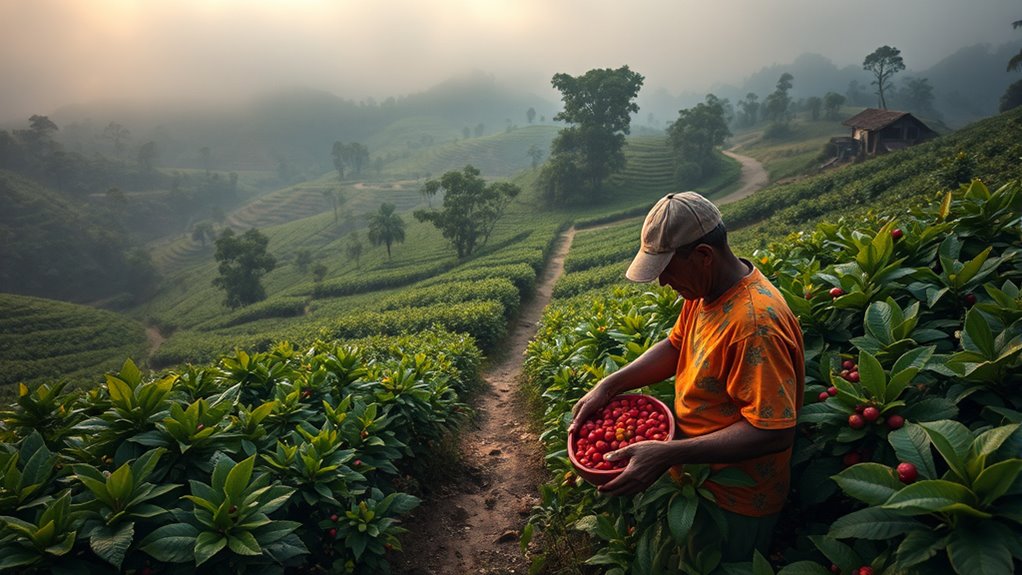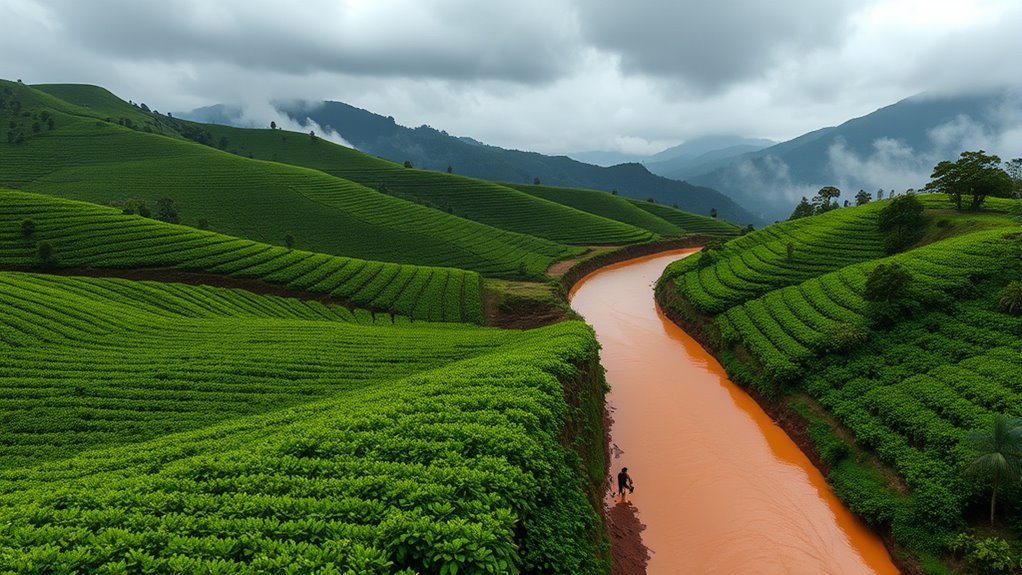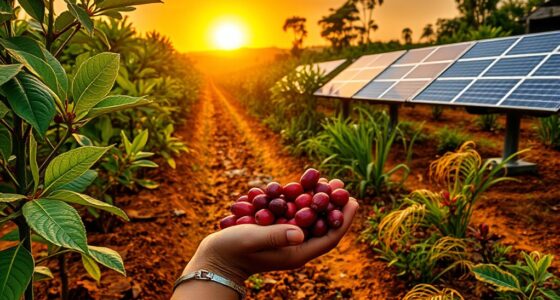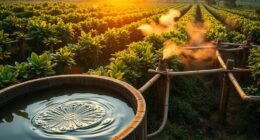Coffee production impacts the environment by causing massive deforestation, which destroys wildlife habitats and contributes to climate change. It also uses large amounts of water, harms ecosystems with fertilizer and pesticide runoff, and depletes soil nutrients through monoculture farming. Additionally, climate change now threatens future yields as rising temperatures make farming more difficult. If you want to understand how your coffee habits affect the planet and what can be done, there’s more to explore.
Key Takeaways
- Coffee cultivation leads to significant deforestation, destroying habitats and contributing to climate change.
- Monoculture farming depletes soil nutrients, causes erosion, and disrupts local ecosystems.
- Water-intensive processing methods and runoff from chemicals pollute water sources and harm aquatic life.
- Heavy pesticide use contaminates soil and water, reducing biodiversity and affecting communities.
- Climate change threatens coffee yields, forcing industry adaptation and risking future production stability.

Coffee production has a significant environmental impact, primarily driven by the extensive land clearing required to meet global demand. Each day, over 200,000 acres are cleared worldwide for coffee cultivation, resulting in widespread deforestation. This process destroys essential wildlife habitats and causes a sharp decline in biodiversity. For every cup of coffee you enjoy, almost one square inch of rainforest is lost, emphasizing how directly your consumption affects delicate ecosystems.
Every cup of coffee contributes to rainforest loss and habitat destruction worldwide.
As forests are replaced with monoculture coffee farms, natural landscapes diminish, leading to environmental degradation and disrupting local ecological balances. Removing forests also releases stored carbon, intensifying climate change and further harming the planet.
The shift from diverse forests to single-crop plantations contributes to soil degradation. Monoculture practices deplete essential nutrients in the soil because they lack crop rotation, making the land less fertile over time. This results in changing soil composition, reduced moisture retention, and increased vulnerability to erosion.
To keep up with production, farmers often rely heavily on fertilizers and pesticides, which accumulate in the soil and runoff into nearby water bodies. These chemicals contaminate water sources, harming aquatic life and affecting communities that depend on clean water.
Additionally, traditional wet processing methods for coffee use vast amounts of water, often leading to waste and water shortages in regions already facing scarcity. The environmental toll extends beyond land and water. Coffee farming consumes large quantities of water for irrigation and processing, contributing to regional water stress. Excessive chemical runoff from fertilizers and pesticides contaminates rivers and lakes, disrupting aquatic ecosystems and harming fish and other wildlife.
The widespread use of pesticides is a concern; in 2005, over 5 million tons were used globally, with resistance in pests prompting increased application rates. This chemical buildup damages ecosystems and threatens biodiversity.
Efforts to reduce chemical use are crucial but challenging, as sustainable practices require significant changes in farming methods. Climate change adds another layer of threat to coffee production. Rising temperatures and unpredictable weather patterns stress coffee plants, reducing yields and threatening the livelihoods of farmers.
Environmental stressors alter plant growth and biochemical processes, making coffee cultivation more difficult and less predictable. As climate change accelerates, many regions may become unsuitable for traditional coffee farming, forcing the industry to adapt or face decline.
This vulnerability underscores how intertwined coffee’s environmental footprint is with broader ecological challenges. Implementing sustainable farming practices can help mitigate some of these impacts, but widespread adoption remains a challenge. While many stakeholders recognize these issues and are working toward sustainable initiatives, the ongoing environmental costs of coffee production remain substantial. Understanding the full scope of its ecological impact can motivate consumers and producers alike to seek more sustainable alternatives, helping to preserve vital ecosystems for future generations.
Frequently Asked Questions
How Does Coffee Cultivation Affect Local Biodiversity?
You might wonder how coffee cultivation affects local biodiversity. When you choose traditional or shade-grown coffee, you help preserve habitats, support diverse species, and maintain healthy ecosystems.
However, if you opt for intensive, sun-grown varieties, you contribute to deforestation, habitat loss, and reduced wildlife diversity. Your choices can either harm or help local plants and animals, so supporting sustainable practices makes a positive difference for biodiversity.
What Are Sustainable Alternatives to Traditional Coffee Farming?
You’re exploring sustainable alternatives to traditional coffee farming, and there are several options. Shade-grown coffee promotes biodiversity and soil health, while agroforestry integrates trees to absorb carbon and support ecosystems.
Organic farming avoids harmful chemicals, and crop diversification builds resilience. By adopting these practices, you help protect the environment, improve farm sustainability, and meet increasing market demand for eco-friendly coffee.
This ensures long-term benefits for both farmers and ecosystems.
How Does Coffee Processing Impact Water Quality?
You mightn’t realize it, but coffee processing can seriously harm water quality. When untreated wastewater from processing plants gets dumped into rivers, it releases high levels of organic matter and acidity.
This depletes oxygen and harms aquatic life.
This pollution affects communities relying on these water sources, leading to health risks and economic problems.
Without proper treatment, this damage worsens over time, making water pollution a critical issue linked directly to coffee production.
Are There Eco-Friendly Certifications for Coffee Producers?
You’re wondering if there are eco-friendly certifications for coffee producers. Yes, several certifications promote sustainable practices, like Bird-Friendly, USDA Organic, Rainforest Alliance, and Fair Trade.
These programs encourage shade-grown coffee, chemical-free farming, biodiversity, and fair labor conditions. By choosing coffee with these labels, you support environmentally friendly methods that protect ecosystems, conserve resources, and improve farmers’ livelihoods.
Your purchase can make a positive impact on the planet.
How Can Consumers Reduce Coffee’S Environmental Footprint?
Think of your coffee cup as a symbol of change. You can reduce its environmental footprint by choosing plant-based milk, which lowers emissions.
Always opt for reusable cups to cut waste, and avoid single-use pods and pre-made drinks.
Supporting sustainable coffee brands and recycling packaging show your commitment.
Conclusion
While coffee might seem harmless, think about the lush forests lost to make way for plantations. If you keep supporting unsustainable practices, those vibrant ecosystems could disappear, leaving only barren lands and lost biodiversity. But by choosing ethically sourced coffee, you help protect these essential habitats. Imagine your morning cup fueling positive change, preserving the beauty and balance of our planet for generations to come. Every sip can be a step toward a healthier environment.









